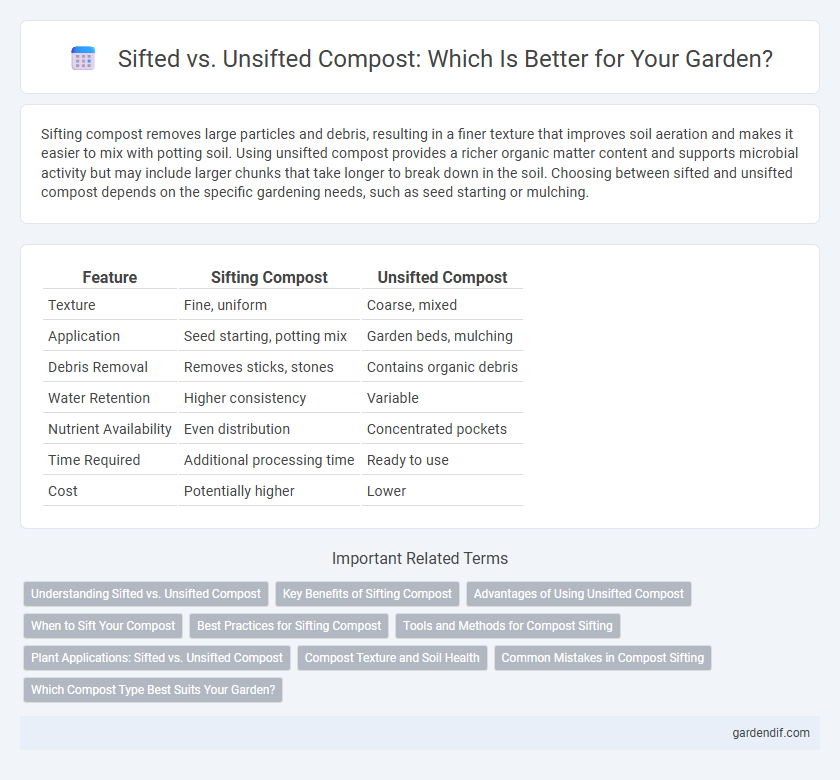
Sifting Compost vs Using Unsifted Compost Illustration
Sifting compost removes large particles and debris, resulting in a finer texture that improves soil aeration and makes it easier to mix with potting soil. Using unsifted compost provides a richer organic matter content and supports microbial activity but may include larger chunks that take longer to break down in the soil. Choosing between sifted and unsifted compost depends on the specific gardening needs, such as seed starting or mulching.
Table of Comparison
| Feature | Sifting Compost | Unsifted Compost |
|---|---|---|
| Texture | Fine, uniform | Coarse, mixed |
| Application | Seed starting, potting mix | Garden beds, mulching |
| Debris Removal | Removes sticks, stones | Contains organic debris |
| Water Retention | Higher consistency | Variable |
| Nutrient Availability | Even distribution | Concentrated pockets |
| Time Required | Additional processing time | Ready to use |
| Cost | Potentially higher | Lower |
Understanding Sifted vs. Unsifted Compost
Sifting compost removes larger debris and uncomposted materials, resulting in a finer, more uniform product ideal for seed starting and delicate plants. Unsifted compost retains organic matter variability, providing a diverse nutrient profile and improved soil structure for garden beds and mulching. Choosing between sifted and unsifted compost depends on plant type, soil texture, and gardening goals to optimize nutrient availability and soil aeration.
Key Benefits of Sifting Compost
Sifting compost removes large particles, debris, and contaminants, resulting in a finer, more uniform texture that promotes better soil aeration and faster nutrient absorption by plants. This process enhances soil structure, improves seedling growth, and facilitates even water distribution. Using sifted compost ensures a high-quality amendment that supports healthier root development and reduces the risk of pests and diseases.
Advantages of Using Unsifted Compost
Using unsifted compost retains a higher content of organic matter, which improves soil structure and moisture retention more effectively than sifted compost. The presence of larger particles in unsifted compost aids in promoting soil aeration and supports beneficial microbial activity. Additionally, unsifted compost reduces labor and waste, making it a cost-effective and eco-friendly option for gardeners.
When to Sift Your Compost
Sifting compost is essential when preparing fine-textured soil for seedlings or delicate plants, as it removes larger debris and ensures uniform nutrient distribution. Unsifted compost is suitable for garden beds or mulch applications where organic matter breakdown occurs naturally over time. Choosing to sift depends on the plant type and growth stage, optimizing compost effectiveness and soil health.
Best Practices for Sifting Compost
Sifting compost improves soil texture by removing large clumps and debris, ensuring a finer, more uniform material that enhances root contact and nutrient absorption. Best practices for sifting compost include using a mesh screen with appropriate hole size to balance particle size and airflow, and sifting when the compost is adequately moist but not too wet to prevent clogging. Properly sifted compost promotes healthier plant growth and reduces the risk of pests or weed seeds that may be present in unsifted compost.
Tools and Methods for Compost Sifting
Compost sifting involves using tools like rotary sifters, drum screens, or hand-held mesh sieves to separate fine compost from larger debris, enhancing soil texture and nutrient availability. Methods range from manual raking and shaking through wire mesh to mechanical tumblers that improve efficiency and reduce labor. Proper sifting tools prevent clumps and ensure uniform compost quality, optimizing plant growth and soil health.
Plant Applications: Sifted vs. Unsifted Compost
Sifted compost provides a finer texture that improves soil aeration and promotes uniform root growth, making it ideal for seedlings and delicate plants. Unsifted compost contains larger organic particles that enhance soil structure and water retention, benefiting established plants with deeper root systems. Choosing between sifted and unsifted compost depends on specific plant needs and growth stages, optimizing nutrient availability and soil health.
Compost Texture and Soil Health
Sifting compost improves texture by removing coarse materials, resulting in a finer, more uniform consistency that enhances soil aeration and root penetration. Unsifted compost retains larger organic particles, which decompose over time and gradually enrich soil structure with beneficial microbes and nutrients. Both methods support soil health, but sifting accelerates compost integration while unsifted compost provides long-term organic matter benefits.
Common Mistakes in Compost Sifting
Common mistakes in compost sifting include over-sifting, which removes valuable nutrients and beneficial microorganisms, and under-sifting that leaves large debris and undecomposed materials, hindering soil integration. Using improper screen sizes can either waste fine compost particles or fail to filter out coarse materials effectively. Neglecting to sift compost before application often results in uneven nutrient distribution and poor soil aeration, impacting plant growth negatively.
Which Compost Type Best Suits Your Garden?
Sifting compost removes large debris and creates a finer texture, promoting faster nutrient absorption and better root contact, ideal for seed starting and delicate plants. Unsifted compost retains organic matter pieces that enhance soil structure and encourage microbial activity, benefiting established garden beds and heavy feeders. Choosing between sifted or unsifted compost depends on the specific plant needs and garden stage, ensuring optimal growth and soil health.
Sifting Compost vs Using Unsifted Compost Infographic

 gardendif.com
gardendif.com